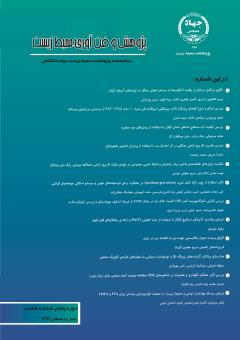بررسی کارایی نانوکامپوزیت آهن (III) اکسید/ خاک اره در حذف COD از شیرابه لندفیل: بهینهسازی و بررسی ایزوترم جذب
محورهای موضوعی : تکنولوژی آب و فاضلاب
نیلوفر عابدین زاده
1
,
حمید شرفی نسب
2
,
فریبا استوار
3
![]()
1 - پژوهشکده محیط زیست جهاددانشگاهی
2 - موسسه آموزش عالی جهاد دانشگاهی
3 - پژوهشکده محیط زیست جهاددانشگاهی
کلید واژه: نانوذرات مغناطیسی, شیرابه لندفیل, نانوکامپوزیت, تصفیه, COD, ایزوترم,
چکیده مقاله :
یکی از مشخصههای زبالههای شهری، درصد بالای مواد آلي فسادپذیر است که با تولید میزان قابلتوجهی شیرابه همراه است. شیرابه حاصل از زباله، اعم از زبالههای تـازه، تودههای کمپوست و یا محل دفن، دارای انواع مـواد آلی و معدنی بـه شکل معلق و محلول بـوده و همچنین ممکن است دارای انواع عوامل بیماریزا و ترکیبات فلزات سنگین نیز باشد. بنابراین شیرابه حاصله میتواند منجر بـه مشکلات محیط زیستی بسیاری شـود. هدف از این پژوهش، حذف COD شیرابه مراکز دفن زباله با استفاده از نانوکامپوزیت مغناطیسی زیستی آهنIII) ) اکسید/خاک اره است. ابتدا نانوکامپوزیت مغناطیسی Fe3O4/SD به روش رسوبدهی شیمیایی سنتز شد و بررسی ساختار و مورفولوژی نانوکامپوزیت سنتز شده، با تکنیک اسکن اشعه ایکس (XRD) و میکروسکوپ الکترونی روبشی میدانی (FE-SEM) انجام گرفت. سپس، اثر متغیرهای تأثیرگذار بر فرآیند جذبی شامل pH، زمان تماس، مقدار جاذب و دما بر حذف شاخص COD بررسی شد. نتایج پارامترهای تأثیرگذار نشان داد که بیشترین راندمان حذف COD در pH برابر 7، مقدار جاذب 4/0 گرم، زمان تماس 45 دقیقه و دمای 45 درجه سانتیگراد با راندمان حذف حدود 70 درصد مشاهده شده است. بررسیهای ایزوترمی نیز نشان داد که فرآیند حذف از ایزوترم فروندلیچ تبعیت بیشتری کرده (9243/0 R2=) و ناهمگن بودن و چند لایه بودن فرآیند جذب تایید شد. درنهایت، نتایج نشان داد که تصفیه بار آلی شیرابه مراکز لندفیل با استفاده از فرآیند جذبی نانوکامپوزیت مغناطیسی آهنIII)) اکسید/خاک اره امکانپذیر بوده و میتوان به عنوان روشی کارآمد در تصفیه شیرابه مراکز لندفیل و کارخانجات کمپوست بکار برد.
One of the characteristics of municipal wastes is the high percentage of perishable organic matter, which is associated with a significant amount of leachate production. Waste leachate, whether fresh, compost or landfill leachate, has a variety of suspended and soluble organic and inorganic materials, and may also contain a variety of pathogens and heavy metal compounds. Therefore, the leachate can lead to many environmental problems. The purpose of this study is COD removal from landfill leachate using bio-magnetic iron (III) oxide/sawdust nanocomposite. First, Fe3O4/SD magnetic nanocomposite was synthesized by the chemical precipitation method and the structure and morphology of the synthesized nanocomposite were investigated using X-ray Diffraction (XRD) and Field Scanning Electron Microscopy (FE-SEM) technique. Then, the effect of influential variables on the adsorption process including pH, contact time, adsorbent amount, and temperature on the removal of COD were investigated. The results of effective parameters showed that the highest COD removal efficiency was observed at pH 7, the adsorbent amount of 0.4 g, the contact time of 45 minutes, and the temperature of 45°C with a removal efficiency of about 70%. Also, the isotherm studies confirmed that the removal process followed the Freundlich isotherm more closely (R2= 0.9243) and the heterogeneity and multilayers of the adsorption process were confirmed. Finally, the results showed that treatment of the landfill centers leachate's organic load is possible using the adsorption process of Fe3O4/SD magnetic nanocomposite and can be used as an efficient method in leachate treatment of landfill centers and compost plants.


